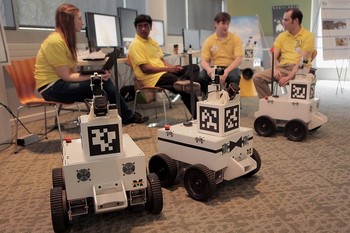Autonomous robots, vehicles hot topic during annual U-M Robotics Day

Team VIRUS' glowing FIRST Robotics Competition entry sits in front of Willow Run students Zachary Holloway, right, Michael Justice, center, and homeschooler Justin Bruck during the second annual Michigan Robotics Day at the North Campus Research Complex in Ann Arbor on Monday, April 9, 2012. Chris Asadian | AnnArbor.com
-
Team VIRUS' glowing FIRST Robotics Competition entry sits in front of Willow Run students Zachary Holloway, right, Michael Justice, center, and homeschooler Justin Bruck during the second annual Michigan Robotics Day at the North Campus Research Complex in Ann Arbor on Monday, April 9, 2012. Chris Asadian | AnnArbor.com /calendar/photologue/photos/web040912_Robotics_Day_CA/cache/040912_Robotics_Day_CA_001_fullsize.JPG
-
A remote-controlled robotic arm attempts to grasp a rubber tube. Chris Asadian | AnnArbor.com /calendar/photologue/photos/web040912_Robotics_Day_CA/cache/040912_Robotics_Day_CA_002_fullsize.JPG
-
Adam Junkins, from Chelsea High School Robotics, operates joysticks to maneuver a robot around. Chris Asadian | AnnArbor.com /calendar/photologue/photos/web040912_Robotics_Day_CA/cache/040912_Robotics_Day_CA_003_fullsize.JPG
-
An Xbox gamepad is used to steer a robot. Chris Asadian | AnnArbor.com /calendar/photologue/photos/web040912_Robotics_Day_CA/cache/040912_Robotics_Day_CA_004_fullsize.JPG
-
Bo Cui, University of Detroit Mercy electrical engineering grad student, focuses on a laptop screen. Chris Asadian | AnnArbor.com /calendar/photologue/photos/web040912_Robotics_Day_CA/cache/040912_Robotics_Day_CA_005_fullsize.JPG
-
A robotic fish floats inside an aquarium at the display by Michigan State University's Department of Electical and Computer Engineering. Chris Asadian | AnnArbor.com /calendar/photologue/photos/web040912_Robotics_Day_CA/cache/040912_Robotics_Day_CA_006_fullsize.JPG
-
Stephen Chaves, U-M Perceptual Robotics Laboratory Ph.D student, tells a group about the Parrot AR.Drone he's holding. Chris Asadian | AnnArbor.com /calendar/photologue/photos/web040912_Robotics_Day_CA/cache/040912_Robotics_Day_CA_007_fullsize.JPG
-
MI Robotics Ph.D students hang out by their award-winning autonomous robots. Chris Asadian | AnnArbor.com /calendar/photologue/photos/web040912_Robotics_Day_CA/cache/040912_Robotics_Day_CA_008_fullsize.JPG
-
A silver tape-wrapped tennis ball represents the people that robots have to rescue from a fictional burning building in the upcoming Robofest 2012 World Championship. Chris Asadian | AnnArbor.com /calendar/photologue/photos/web040912_Robotics_Day_CA/cache/040912_Robotics_Day_CA_009_fullsize.JPG
-
Tyler Danielak, of Capac High School Robotics, holds up a rubber tube while a robot propels a basketball through the hole. Chris Asadian | AnnArbor.com /calendar/photologue/photos/web040912_Robotics_Day_CA/cache/040912_Robotics_Day_CA_010_fullsize.JPG
-
A robotic arm developed by Rochester Hills-based FANUC Robotics whizzes around. Chris Asadian | AnnArbor.com /calendar/photologue/photos/web040912_Robotics_Day_CA/cache/040912_Robotics_Day_CA_011_fullsize.JPG
-
Engineering professor Dr. Lawrence Burns gives a keynote address from behind a podium. Chris Asadian | AnnArbor.com /calendar/photologue/photos/web040912_Robotics_Day_CA/cache/040912_Robotics_Day_CA_012_fullsize.JPG
Fifth-year University of Michigan mechanical engineering doctoral student Ayoung Kim envisions a time when humans handle the complicated cognitive tasks and leave much of the rest to robots.
"A lot of work now is done jointly by humans and robots, but humans could do much higher-level things and let the minor and miscellaneous stuff be taken care of by robots," Kim said. "There's a part a human can do well and there's a part robots can do well."
Kim is far from alone. She was joined by hundreds of fellow engineers and scientists at U-M's annual Robotics Day held at the North Campus Research Center, formerly Pfizer's local headquarters.
Kim and fellow researchers presented robots they've designed and developed and discussed the future of automated machines, including what some consider is an imminent move toward self-driving vehicles.
"We are talking about reinventing the automobile," university engineering professor Lawrence Burns, a former General Motors vice president for research and development and current Google adviser, told a crowd of more than 200 Monday. "You're going to have self-driving and driverless vehicles mixed with people driving vehicles."

MI Robotics Ph.D students hang out by their award-winning autonomous robots.
Chris Asadian | AnnArbor.com
First-year U-M mechanical engineering doctoral student Stephen Chaves is helping develop the helicopter with a team of other graduate and undergraduate students. The robot is funded by a U.S. Navy grant fostering the creation of automated robots that use radar and laser sensors instead of GPS mapping signals, which are vulnerable to enemy interference.
The helicopter is designed to launch, navigate and land itself entirely using sensors.
"GPS is probably the most reliable way to do this but we want to demonstrate it can be done without GPS systems," Chaves said. "Because what if those GPS signals were scrambled or they were blocked? That's a common tactic in wartime."
While the unmanned arial robot isn't new —the U.S. military widely uses drones— Kim says researchers still need to master the "robustness, efficiency and speed" of autonomous vehicles that don't use GPS navigation systems.
"We can eliminate humans in the loop for military actions, which are often dangerous," said Chaves. "The computers can react instantaneously and sometimes a human can't do that or is incapable of reaching these obscure locations."
Further, designing and building the unmanned arial robot is an invaluable learning tool, Chaves said.
"The reason we're doing this project is not so much that it's novel or groundbreaking. It's that we're trying to integrate the project-based learning into teaching," he explained. "It's not so much about accomplishing the task as it is about accomplishing the task while educating everyone."
Often mechanical engineering students spend more of their time simulating theory and design on their computers than they do applying it in the real world, Kim says. During her two years helping to develop an underwater robot designed to survey deep undersea using sonar sensors and a camera-based memory system, instead of a GPS, Kim has been able to spend the majority of her time working on a three-dimensiional, real-world object.
"It’s a really great experience to have something real to show for all my work. A real robot," she said. "We really can see if something is working or not. The real-world implementation is the really fun part."
That real-world implementation phase is on the precipice for driverless vehicles, Burns predicts.
He expects companies will start rolling out driverless features by 2014 or 2015 and envisions a time not too long after when vehicles aren't owned singularly, they're shared. Similar to Netflix, someone could order a vehicle for an outing, that vehicle would drive itself to his door and then drive him to his desired location. If such a system materializes, the number of vehicles in Ann Arbor would shrink from 200,000 to 30,000, Burns estimates.
"This is a big business opportunity for people that get it right," he said, predicting that the technology for such a system will develop more quickly than consumer readiness. Nonetheless, the possibilities for such a system are vast, he said. "It's a fun place to be."
Kellie Woodhouse covers higher education for AnnArbor.com. Reach her at kelliewoodhouse@annarbor.com or 734-623-4602 and follow her on twitter.


 The Lunch Room does vegan food in a way that even non-vegans can enjoy
The Lunch Room does vegan food in a way that even non-vegans can enjoy Images from Dawn Farm's 40th Anniversary Jamboree
Images from Dawn Farm's 40th Anniversary Jamboree See photos from Kerrytown BookFest
See photos from Kerrytown BookFest Images from Michigan's 41-30 win over Notre Dame under the lights
Images from Michigan's 41-30 win over Notre Dame under the lights
Comments
Ignatz
Tue, Apr 10, 2012 : 12:53 p.m.
I'd be interested in knowing what the financial implications might be vis-a-vis accident insurance for automated vehcles. Would the insurance companies charge the engineers responsible for the design should accidents occur? Speaking for myself, I would never go in one of these things. I'd like to be responsible for my own adrenaline rush, thank you.